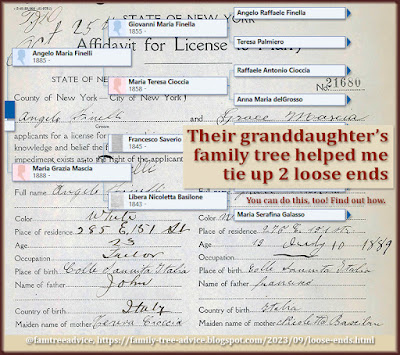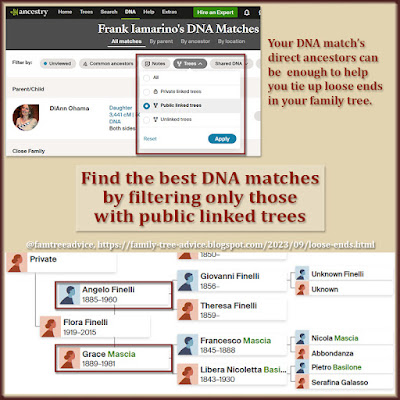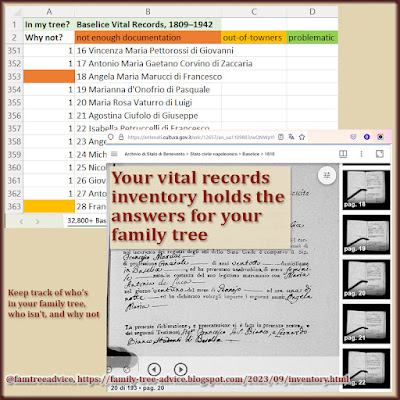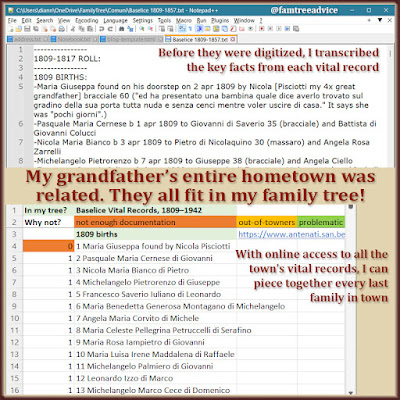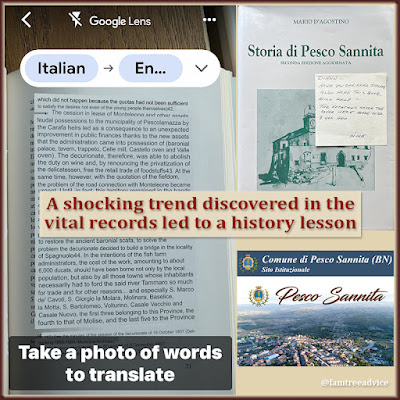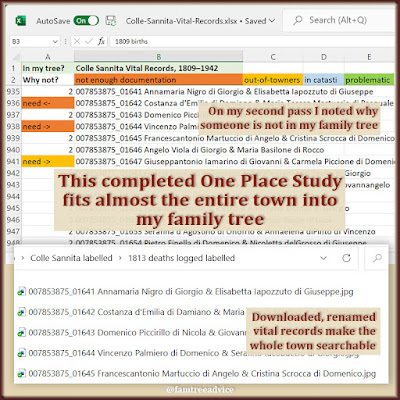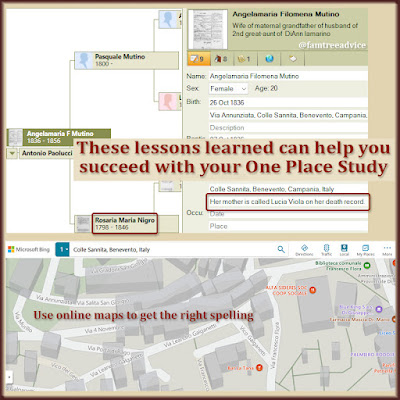 |
| Is something wrong on that vital record? Don't turn the page. Know how to spot a simple mistake. |
Vital records are crucial pieces of your family history. Without them, I would have no information at all about my ancestors from the old country.
But, is every vital record 100% correct? Of course not. Vital records have mistakes for many reasons, including:
- Clerical error. The town clerk recording the vital record may write something in error. They're only human and they can make mistakes.
- Lack of knowledge. Imagine a death record for someone born in another country. Their son is the informant. He provides the names of his grandparents, but he never met his grandparents. He may never have known his grandmother's maiden name.
- Misunderstanding. The person writing the information may not hear a name correctly. Or there may be some confusion about a particular detail.
- Local and cultural customs. Lots of people go by their middle name. When your daughters are Maria Rosa, Maria Teresa, and Maria Angela, they can't all go by Maria! And what happens to a family when they move to another country and try to fit in? Often they change their names.
If you know which types of mistakes you may find on a vital record, you can recognize and deal with them. Here are 5 common mistakes to look for on vital records.
1. Wrong Parent's Name on a Birth, Death, or Marriage Record
If 5 out of 6 names are correct on a vital record, that 6th name could be an error. Imagine a birth record where the baby's first and last names are what you expected. It's your grandmother's full name. And her father's first and last names are correct. But when you look at her mother, her first name is right and her last name is wrong. So, 5 out of 6 names are correct. Is it your grandmother's birth record?
Take a look at the rest of the details. Is the place correct? Is your great grandfather's occupation correct? Is there another couple in town with the names you see on this document?
Whenever I record a vital record in my family tree that has an error, I make note of it. In the birth date's description field, I add a standard phrase. For example, "Her mother's last name is Ferraro on her birth record". This tells me, and anyone who finds my tree online, that I'm aware of the discrepancy, but I've done my homework. (It's helpful to have standard phrases to use in your family tree.)
I learned a helpful fact about Italian vital records that can come into play with this type of error. Sometimes they can record a woman's name using her mother's maiden name. I don't know why—to distinguish her from another woman with her name? But I have seen it happen.
 |
| When you've researched the whole family, a name error on one vital record won't ruin your day. |
2. Wrong Sibling's Birth Date on a Marriage Record
In some countries it was common to re-use a first name among your children. If your baby Giovanni died, you named your next baby boy Giovanni. When the second Giovanni grew up and married, what if a clerk found the first Giovanni's birth record? He'd enter that date into the marriage record.
I've seen this happen a lot. It's only because I've already documented the death of Giovanni #1 that I know this is an error. To keep from recording an error in your family tree, research the whole family.
3. Wrong Grandparent's Name on a Birth, Death, or Marriage Record
It's very common to see the wrong names on a U.S. death record of someone born overseas. My great grandmother's brother was born Giuseppe Antonio Caruso. On his 1949 U.S. death certificate, he is Joseph A. Caruso. The informant was one of his daughters, Rose. Rose never met her grandparents in Italy. She named them as Frank (he was Francesco) and Maria Gerard. Maria's last name had been a roadblock for me, but I knew Gerard was going to be a clue. Piecing together clues, I found it. Her name was Girardi! Rose seems to have used a more American version of the name.
When my 2nd great grandfather died in New York in 1925, his eldest son was the informant. He said my 3rd great grandmother was Mary Piseo. You know what Italian documents say her name was? Grazia Ucci. Talk about a red herring.
On many Italian vital records, they wrote a person's name and then their father's first name. (See "3. Grandfathers' Names".) This can be so helpful in telling same-named people apart. In particular, birth records in the 1860s–1870s include the two parents' fathers' names. But sometimes there's a mistake. The record may say Antonio is the son of Giovanni when he was the son of Giuseppe. As with error #1 above, you have to consider all the details on a document to see if this is nothing more than a mistake.
4. Person Goes By a Different Name
When my mother was born, they asked her immigrant father, "What is the baby's name?" He said Mariangela. My grandmother was out cold, so she couldn't speak up. Mariangela was not the plan. A clerk recorded the name as Marie Angela. The plan was to name her Maryann, and that's always been her name.
The story is that my grandfather wanted to name her after his mother, Mariangela. Then I came along and became a genealogist. You know what I found? My great grandmother's 1 Jan 1856 birth record says she is Marianna. (That's way closer to Maryann, by the way.) So who is Mariangela?
Researching her entire family, I found 7 siblings. The first child, born in 1843, was Mariangela. She died in 1847. The sixth child was Marianna…sometimes. When Marianna married in 1881, she was still Marianna. But when her first and fourth children were born, she was Mariangela. Her name kept going back and forth. I suspect she went my the name Mariangela within her family as a tribute to her dead sister. But on some official documents, she used her proper name of Marianna. My grandfather must have known her as Mariangela.
Follow their complete paper trail to figure out what's a mistake, what's a custom, and what's a matter of fitting in.
5. Complete Change of Name in a New Country
Some of our ancestors hung onto their ethnic identity more than others. I'm impressed that my grandfathers hung onto their Italian names for life. Some people called them Adam and Peter, but every document calls them Adamo and Pietro. Their American children change how they pronounced their last names. But Adamo and Pietro stuck to the origin pronunciation.
This is not the norm. I've documented so many distant relatives who came to America from Italy. Most Giuseppes became Joe. Most Giovannis became John, my great grandfather included. My grand aunt Assunta became Susie.
You may have family members who ditched their ethnic birth name for a more common name. In my family tree I have a Ross who was born Rosario, a Sam who was born Semplicio, and a Julia who was born Giovina.
You need to recognize and look past a name change when seeking vital records for your family member. A family from my great grandparents' town had the last name Muollo (my 2nd great grandmother's name). The family settled in Pennsylvania. Muollo is so hard for an American mouth to say (mwo-lo) that they changed it to Williams. Williams! If a member of that family hadn't told me this, I'd have lost track of the entire group.
If you're trying to follow a family that changed its last name, pay attention to the first names. Let's say I didn't know the Muollos became the Williamses, and I decided to look at the census records for their town. If I found a family that included Ernest, Michael, Teresa, Carl, and Mary Rose, I'd know this was the Muollo family.
Try to find documents to support that name change. Then change your search to include the new name.
Mistakes can happen. They do happen. Know what to look for, do your research, and you can deal with the inevitable mistakes on vital records.
Have you missed any of these recent articles from Fortify Your Family Tree?



